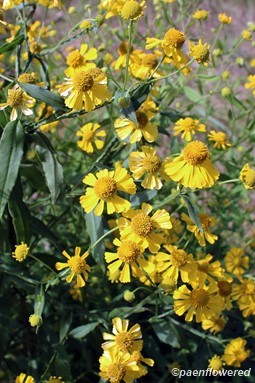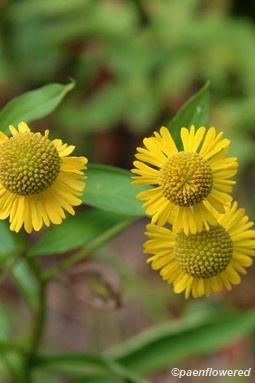Helenium autumnale
Helenium autumnale common sneezeweed
This sturdy native perennial wildflower is another of the group plants in the aster family that are often grouped, in common perception, with the sunflowers. In this case the composite flowers has ten to twenty drooping yellow ray florets. Each of these petal-like rays has three scallops at their edges. The central disk is globular and ocher-yellow in color. The disk flowers are tubular. Both the disk and the ray florets are fertile. Each flower head is one to two inches in diameter.
The leaves are six inches long, lance-shaped, toothed and alternate on the stem. The base of the flower extends down the stems to form “wings.” The stem is stout, smooth and has many branches. The fruit is an achene without any hairy tufts and which is partly water-distributed. The plant grows 2-5 feet tall in sunny or partly shaded areas of thickets, swamps, in wet meadows and along the sides of streams throughout much of the eastern half of North America, except for the Maritime Provinces of Canada and the Arctic. It blooms from August to November.
The common name does not refer to summer allergies, as the pollen is not distributed by the wind. Instead it is due to the historical use of the dried leaves to make snuff that caused sneezing when inhaled. This was believed to be a treatment for the common cold and other respiratory diseases. All parts of the plant are poisonous if eaten. Because of its toxic effect on livestock it is considered a weed in some places. The leaves contain a compound called lactone that has been medically found to have some anti-tumor qualities.
Habitat & Range
Common in swamps, wet fields, and moist edges of streams.
Present throughout the state.
| EMP: | FACW |
|---|---|
| NCNE: | FACW |
Phenology
Flowers July through November.
Plant Codes
S-rank: No rank
G-rank: G5 (Secure)





Comments
Have you spotted this plant in your area? We'd love to hear about your experience! Share your comments or questions about the plant below. Comments are moderated before posting.